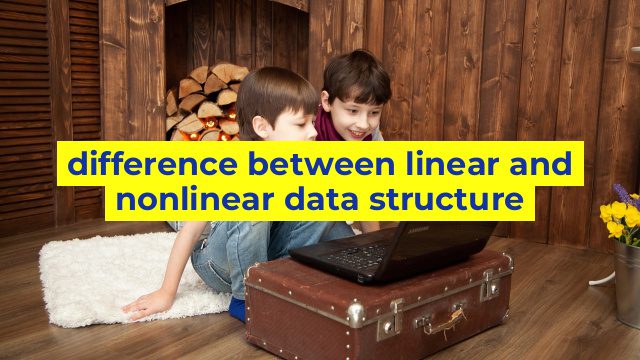The Difference Between Linear and Nonlinear Data Structures
When it comes to computer programming, data structures are used to store and organize data in a way that allows for easy and efficient access and manipulation. There are two main types of data structures: linear and nonlinear. In this article, we’ll explore the differences between them.
Linear Data Structures
A linear data structure is a data structure where data elements are organized sequentially, one after another. The elements are stored in a linear manner, and there is a clear and distinct ordering of the data. Examples of linear data structures include arrays, linked lists, stacks, and queues.
Arrays are perhaps the most common type of linear data structure. In an array, each element is accessed by its index, or position in the array. This makes accessing, searching, and sorting the elements fast and straightforward.
Linked lists are another type of linear data structure. In a linked list, each element points to the next one, forming a chain. This allows for efficient adding and removing of elements, as only the pointer needs to be adjusted.
Stacks and queues are also linear data structures, but with some restrictions. Stacks allow access only to the last element added (known as Last in, First out, or LIFO), whereas queues allow access to the first element added (known as First in, First out, or FIFO).
Nonlinear Data Structures
In contrast to linear data structures, nonlinear data structures do not have a clear and distinct ordering of the elements. Instead, they allow for elements to be organized in more complex and flexible ways. Examples of nonlinear data structures include trees and graphs.
Trees are a hierarchical structure where each node can have more than one child. They are often used to represent hierarchical relationships, such as file systems or organizational charts.
Graphs are a more general type of nonlinear data structure that allows for more complex relationships between nodes. They can represent almost any type of relationship or network, from social networks to transportation systems.
Conclusion
In summary, linear data structures have a clear and distinct ordering of data elements, making them useful for accessing, searching, and sorting data in a straightforward manner. Nonlinear data structures allow for more complex and flexible organization of data elements, making them well-suited for representing complex relationships and networks. Understanding the differences between these two types of data structures is essential for any programmer looking to optimize their code and improve its efficiency.
Table difference between linear and nonlinear data structure
| Linear Data Structure | Nonlinear Data Structure |
|---|---|
| A linear data structure is a data organization method in which elements are arranged sequentially or linearly. | A nonlinear data structure is a data organization method in which elements are not arranged in sequential or linear order. |
| Linear structures are easy to implement and understand. | Nonlinear structures are complex and require complex algorithms for implementation and understanding. |
| Examples of linear data structures include arrays, linked lists, stacks, and queues. | Examples of nonlinear data structures include trees, graphs, and heaps. |
| Linear data structures are suitable for simple linear problems where there is a fixed size of data. | Nonlinear data structures are suitable for complex problems where there is a large amount of data and relationships among the data need to be maintained. |
| Linear data structures have a linear time complexity, which means time to access any element of data is constant. | Nonlinear data structures have a more complex time complexity, and it depends on the size of data, the particular algorithm used, and the relationship among data elements. |
